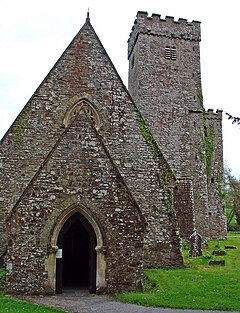Llawhaden
| Llawhaden | |
|---|---|
 St Aidan's church | |
Location within Pembrokeshire | |
| Population | 688 (2011)[1] |
| OS grid reference | SN072175 |
| Community |
|
| Principal area | |
| Country | Wales |
| Sovereign state | United Kingdom |
| Post town | Narberth |
| Postcode district | SA67 8 |
| Dialling code | 01437 |
| Police | Dyfed-Powys |
| Fire | Mid and West Wales |
| Ambulance | Welsh |
Carmarthen West and South Pembrokeshire | |
Llawhaden (
Name
The name Llawhaden is an anglicised version of the Welsh form Llanhuadain, and probably means "(monastic) enclosure of St Aidan".[2]
Description

The village is in the form of a large
History
Llawhaden and its larger hinterland (between the
As Marcher Lords, the Bishops of St. Davids had judicial powers over all offences (except high treason), could levy tax, issue charters, raise armies, and start wars. Though part of Dewisland, and ruled by the same person - the Bishop of St. Davids - the detached nature of Llawhaden and its hinterland lead to it being sometimes called the Lordship of Llawhaden, as if it were a distinct Marcher Lordship.
King
The settlement at Llawhaden expanded slightly across the
Llawhaden Bridge, to the east of the village, spans the Eastern Cleddau and is a Grade II* listed structure built in the mid-18th century.[7] There are a number of other listed structures in the parish.[8]
Notable people
Admiral Sir Thomas Foley was born in the parish in 1757.
Parish
Llawhaden[9] was a civil parish with an area of 4,609 acres (1,865 ha).
The parish includes the hamlet of Gelli.
Demographics
The civil parish had population as follows:[10]
| Date | 1801 | 1831 | 1861 | 1891 | 1921 | 1951 | 1981 |
| Population | 371 | 657 | 647 | 547 | 458 | 402 | 336 |
References
- ^ "Community population 2011". Retrieved 20 April 2015.
- ISBN 0-907158-58-7, Vol II, p 420
- ^ a b c d Judgement in Crown Estate Commissioners v (1) Mark Andrew Tudor Roberts (2) Trelleck Estate Ltd: ChD (Mr Justice Lewison), 13 June 2008
- ^ Brian Howells, Pembrokeshire County History, Volume 2, Haverfordwest, 2002, p. 148
- ^ Owen, George, The Description of Pembrokeshire by George Owen of Henllys Lord of Kemes, Henry Owen (Ed), London, 1892
- ISBN 1-85902-120-4.
- ^ "British Listed Buildings: Llawhaden Bridge and River Bank Wall, Llawhaden". Retrieved 28 March 2016.
- ^ "British Listed Buildings: Listed Buildings in Llawhaden, Pembrokeshire, Wales". Retrieved 28 March 2016.
- ^ Llawhaden on Genuki
- ^ OPCS Reports


